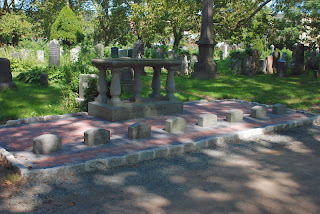
The committee charged with restoring the J.J.J. Gourgas gravesite memorial met today at the site to finalize the plans for the re-dedication ceremony to take place Saturday, October 17.
The progress achieved toward the re-dedication next month of the John James Joseph Gourgas gravesite memorial has been phenomenal. In less than a year, the final resting place of “the Conservator” of the Ancient Accepted Scottish Rite has been transformed from a forgotten, neglected thatch of weeds to its present state of restored dignity and quietude. And there is more work to come.
Gourgas died in 1865 in New York City, and because of a lack of burial space in the city, he was laid to rest in what now is called
Bayview New York Bay Cemetary in Jersey City, New Jersey. The view from this gravesite at that time must have been very pleasing, as it faces New York Harbor and downtown Manhattan. In 1865 the spires of
St. Paul’s Chapel and
Trinity Church would have been the tallest visible structures; the
Statue of Liberty was decades away from being assembled.
In 1938, the Supreme Council dedicated the current gravesite memorial. On October 17, 2009, after all the restoration has been completed, it will be re-dedicated. Supreme Council will open at Peninsula Lodge 99 in Bayonne that morning, and then we’ll take the short ride to the cemetery for the ceremony.

As above: The Gourgas gravesite memorial as it looks today.
So below: The site on August 5, 1938, when the memorial was dedicated.

Needless to say,
The Magpie Mason will provide full coverage of the event, but in the meantime, all this restoration work must be underwritten. Pardon the brazen solicitation, but this is an expensive undertaking. If anyone cares to support this effort, please consider contributing a donation in any amount. Checks can be made payable to
New Jersey Council of Deliberation, and mailed to:
Valley of Southern New Jersey
315 White Horse Pike
West Collingswood, NJ 08107
attn: David Herman
We welcome the financial assistance of not only individuals, but also lodges, grand lodges, Scottish Rite valleys, Councils of Deliberation, historical foundations and societies, and all like-minded conservators of American heritage and Masonic history.

A close-up of the memorial.
It is impossible to count all the Masonic headstones in this cemetary. Brethren from New York and New Jersey are interred here in great numbers, including past grand masters, Supreme Council active members, commanders-in-chief, and other dignitaries.

One of the more attractive headstones
sporting the Square and Compasses
(and the Odd Fellows links).

James W. McCarthy was Scottish Rite Deputy for New Jersey in the early 20th century. He was U.S. Attorney for New Jersey before becoming the U.S. District Court Judge for New Jersey. For many years, the Museum of Masonic Culture at the Valley of Northern New Jersey displayed a slightly larger-than-life bronze bust of this man, whose identity was lost to us until only a few years ago.



















































































